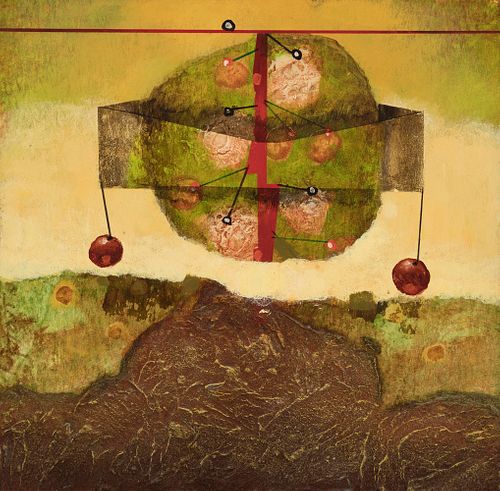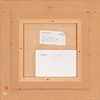MODEST CUIXART I TÀPIES (Barcelona, 1925 - Palafrugell, Girona, 2007). "La buitrera", 1999. Mixed media on board.
Lot 7
About Seller
Setdart Auction House
Carrer Aragó 346
Barcelona
Spain
Setdart Subastas was born in 2004 and is currently the first online art auction in Spain with solidity, prestige and reliability guaranteed by our more than 60,000 users. Setdart has a young, dynamic and enterprising team ready to successfully manage the purchase and sale of art works through custom...Read more
Categories
Estimate:
EUR€800 - EUR€1,000
$842.11 - $1,052.63
Absentee vs Live bid
Two ways to bid:
- Leave a max absentee bid and the platform will bid on your behalf up to your maximum bid during the live auction.
- Bid live during the auction and your bids will be submitted real-time to the auctioneer.
Bid Increments
| Price | Bid Increment |
|---|---|
| EUR€0 | EUR€10 |
| EUR€200 | EUR€25 |
| EUR€500 | EUR€50 |
| EUR€1,000 | EUR€100 |
| EUR€3,000 | EUR€200 |
| EUR€5,000 | EUR€500 |
| EUR€10,000 | EUR€1,000 |
| EUR€20,000 | EUR€2,000 |
| EUR€50,000 | EUR€5,000 |
About Auction
By Setdart Auction House
Oct 27, 2021
Set Reminder
2021-10-27 10:00:00
2021-10-27 10:00:00
America/New_York
Bidsquare
Bidsquare : 19th & 20th Century Paintings & Decorative Arts
https://www.bidsquare.com/auctions/setdart-auction-house/19th-20th-century-paintings-decorative-arts-7767
Setdart Auction House sofia@setdart.com
Setdart Auction House sofia@setdart.com
- Lot Description
MODEST CUIXART I TÀPIES (Barcelona, 1925 - Palafrugell, Girona, 2007). "La buitrera", 1999. Mixed media on board. Presents label of the Alfama Gallery (Madrid). Measurements: 27 x 27 cm; 40,5 x 40 cm (frame). From 1986 to 2007, Cuixart worked in what is known as a period of introspection in nature and mental landscape. During this period the artist was inspired by symbolism, turning to classical sources such as Aristotle or Pericles. Without abandoning his interest in matter, he introduced concepts such as the atom or fractals. Cuixart initially studied medicine, but soon abandoned his studies to devote himself to painting, and entered the Academia Libre de Pintura in Barcelona. In 1948 he participated in the foundation of the group Dau al Set, together with Brossa, Ponç, Tàpies and Tharrats, among others. Concerned with the plastic value of the sign, his work has from the beginning a strong kinship with surrealism, as well as a great sensitivity to the expressive power of color. Towards 1955 he immersed himself in material informalism, which led him to use the "grattage" in works with a certain orientalist flavour. In 1959 he won first prize at the São Paulo Biennial and exhibited at the Documenta in Kassel, and the following year he took part in an exhibition of Spanish avant-garde art held at the Tate Gallery in London and the Guggenheim Museum in New York. Cuixart introduces collage in his work in 1962, which will gradually lead him towards pop-art. Enriched by all these experiences, he returns again to flat painting, reaching a very personal critical realism, which synthesizes expressionism with dramatically transformed figuration, always valuing the chromatic qualities. In the seventies he exhibited in numerous national and international capitals, such as Paris, Madrid, São Paulo, Amsterdam, Tokyo, Basel, Barcelona and Milan, among others. In the following decade, Cuixart gradually freed his painting from its aggressive aspects to give it a more lyrical tone. In addition, he participates in a group exhibition at the UNESCO Palace in Paris, receives the Cross of St. George of the Generalitat of Catalonia, and the Cross of Isabella the Catholic. In 1988, he holds an anthological exhibition in Japan, in the cities of Kobe and Tokyo. He continues to work with exuberant colors and shapes, and reincorporates a more material figuration to his work. In 1998 the foundation that bears his name was created in Palafrugell, and the following year he was awarded the Gold Medal for Merit in Fine Arts by the Ministry of Culture. He is represented in the Museo Nacional Centro de Arte Reina Sofía, the Tate Gallery in London, the Museo Nacional de Arte de Cataluña, the Museo de Arte Contemporáneo in Madrid, Barcelona and Saint-Etienne (France), the Patio Herreriano in Valladolid, the Museo de Grabado Español Contemporáneo in Marbella, the Museo de Arte de la Universidad de São Paulo, the Museo de Arte Abstracto in Cuenca and the Museo del Ampurdán, among many others.
- Shipping Info
-
In-house shipping available. Please inquire at admin@setdart.com.
-
- Buyer's Premium



 EUR
EUR CAD
CAD AUD
AUD GBP
GBP MXN
MXN HKD
HKD CNY
CNY MYR
MYR SEK
SEK SGD
SGD CHF
CHF THB
THB
















